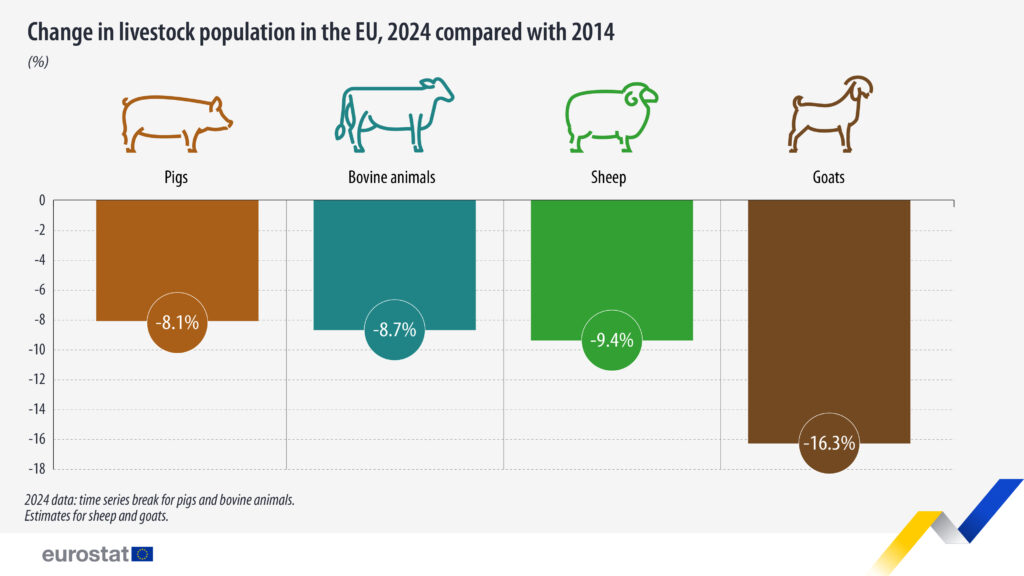EU livestock populations continue to decrease according to Eurostat

Eurostat recently released an important update on the state of livestock populations in Europe: the number of farm animals continues to decline across the European Union. But what do these figures mean? And what are the implications for our food systems, the environment, and the agricultural economy? Let’s take a closer look.
Livestock populations in Europe decreased significantly
In 2024, Europe’s main livestock populations recorded a decrease, continuing the downward trend observed in recent years. Pigs, for example, dropped to around 132 million heads, marking a 0.5% decrease compared to the previous year. The reduction was even more significant for cattle, which fell by 2.8%, settling at around 72 million animals. Sheep also declined by 1.7%, reaching 57 million heads, while goats decreased by 1.6%, down to 10 million. These numbers are not the result of temporary fluctuations, but it is a consolidated trend affecting all major livestock species, regardless of the animal or geographic area, indicating a deeper, structural shift.
According to Eurostat, livestock populations in Europe decreased significantly over a ten-year period from 2014 to 2024. Pig numbers declined by 8.1%, cattle by 8.7%, sheep by 9.4%, and goats by a striking 16.3%. In other words, there are millions fewer animals in Europe today than a decade ago. And this shift is not random. The decline in livestock numbers is the result of multiple overlapping factors, including environmental and regulatory pressures, changing consumer habits, rising production costs, and recurring agricultural crises. European livestock farmers are facing increasing costs, complex regulations, and growing global competition.

EU Farms: a 37% reduction over the past fifteen years
One of the causes is that Europe is pursuing an ecological transition, including in the agricultural sector. Policies such as the Green Deal, the “Farm to Fork” strategy, and plans to cut agricultural emissions led many farms to downsize or shut down operations altogether. As a result, thousands of farms, particularly small, family-run operations, have been forced to close. The number of farms in the European Union decreased significantly from 2005 to 2020, declining from over 14 million to approximately 9.1 million. This represents a loss of around 5.3 million farms, or a 37% reduction over the past fifteen years. This dramatic reduction has been observed across all types of farming, including mixed, livestock-specialist, and crop-specialist farms, with mixed farms and livestock farms being particularly affected.
Fewer farms do not mean more sustainability, but surely less food security
However, fewer farms do not enhance sustainability, and reductions in livestock farms can have counterproductive consequences on multiple fronts. First of all, there is a risk of food production being outsourced: even if fewer animals are raised in Europe, the demand for animal-sourced foods doesn’t disappear, it shifts elsewhere. This means we will ultimately import more meat from countries with significantly lower standards for health, environmental protection, and animal welfare. This not only undermines Europe’s efforts to transition to more sustainable food production but also increases the overall environmental impact due to longer transport distances and less regulated farming practices.
Secondly, excessive reductions in livestock farming is a risk for food security. Food security means a stable and reliable production, and if we focus also on food sovereignty, this means the food supply should be produced locally. Relying increasingly on imports means exposing ourselves to geopolitical crises, volatile markets, and a reduced ability to meet the population’s needs with local resources. Finally, we must not overlook the biodiversity dimension. Extensive livestock farming, particularly in marginal, hilly, or mountainous areas, plays a crucial role in conserving landscapes and biodiversity. These systems keep otherwise abandoned rural areas alive, contribute to soil care and wildfire prevention, and help preserve native breeds and local traditions. Eliminating them would mean losing an irreplaceable cultural and environmental heritage.
Such data compells us to reflect on a crucial point: livestock farming in Europe needs to be revitalised, not reduced. When managed responsibly, livestock can play a key role in sustainable food production.